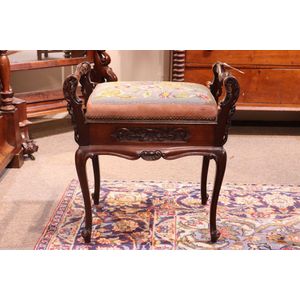Walnut Piano Stool with Carved Foliate Decoration and Storage
Piano stool, early 20th century walnut, carved foliate decoration with sabre legs, lift top seat with storage below, and cross stitch upholstery, height 62 cm, length 58 cm
You must be a subscriber, and be logged in to view price and dealer details.
Subscribe Now to view actual auction price for this item
When you subscribe, you have the option of setting the currency in which to display prices to $Au, $US, $NZ or Stg.
This item has been sold, and the description, image and price are for reference purposes only.
- Sabre Leg - The sabre leg is commonly associated with chairs made in the Regency or classical revival manner of the early 19th century. The form was copied from designs of the ancient Grecian chair known as a klismos found on painted classical vases. The characteristic of the sabre leg is a wide, sweeping backward curve which was frequently reeded, similar to a sabre. The sweep of the front legs was sometimes complemented by a corresponding curve in the back legs of the chair, though on most domestic furniture the sweep of the rear support was not as pronounced. Sabre legs are often encountered in reproductions of the regency style. They are uncommon in Australian furniture where, by and large, colonial craftsmen preferred to use turned legs.
- Cross Stitch - Cross stitch is a form of embroidery that involves creating a pattern or design by sewing X-shaped stitches onto fabric. The stitches are typically made using a needle and thread, and are made in a grid pattern, with each X-shaped stitch crossing over one or more fabric threads. The stitches are usually made with a single thread of embroidery floss, and the thread is passed over one fabric thread and under the next, creating the X-shape.
Cross stitch is one of the oldest forms of embroidery and has been used for centuries to create decorative patterns and designs on clothing, linens, and other fabrics. The technique is simple and easy to learn, making it a popular hobby for people of all ages and skill levels. Cross stitch patterns can range from simple geometric designs to more complex, detailed images such as landscapes, portraits, and characters.
Cross stitch is also used in the production of samplers, a traditional form of embroidery that features a variety of different stitches and patterns produced as a way to practice and demonstrate needlework skills. - Foliate - Decorated with leaves or leaf-like forms.
This item has been included into following indexes:
-
stools, type or function
- piano and music 67
- upholstered 337
